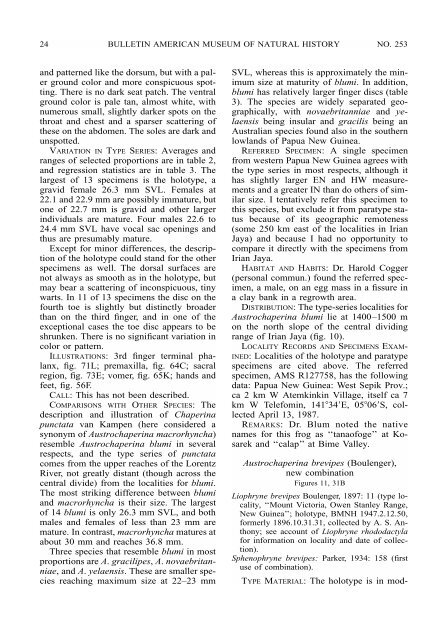SPHENOPHRYNE - American Museum of Natural History
SPHENOPHRYNE - American Museum of Natural History
SPHENOPHRYNE - American Museum of Natural History
You also want an ePaper? Increase the reach of your titles
YUMPU automatically turns print PDFs into web optimized ePapers that Google loves.
24 BULLETIN AMERICAN MUSEUM OF NATURAL HISTORY NO. 253<br />
and patterned like the dorsum, but with a paler<br />
ground color and more conspicuous spotting.<br />
There is no dark seat patch. The ventral<br />
ground color is pale tan, almost white, with<br />
numerous small, slightly darker spots on the<br />
throat and chest and a sparser scattering <strong>of</strong><br />
these on the abdomen. The soles are dark and<br />
unspotted.<br />
VARIATION IN TYPE SERIES: Averages and<br />
ranges <strong>of</strong> selected proportions are in table 2,<br />
and regression statistics are in table 3. The<br />
largest <strong>of</strong> 13 specimens is the holotype, a<br />
gravid female 26.3 mm SVL. Females at<br />
22.1 and 22.9 mm are possibly immature, but<br />
one <strong>of</strong> 22.7 mm is gravid and other larger<br />
individuals are mature. Four males 22.6 to<br />
24.4 mm SVL have vocal sac openings and<br />
thus are presumably mature.<br />
Except for minor differences, the description<br />
<strong>of</strong> the holotype could stand for the other<br />
specimens as well. The dorsal surfaces are<br />
not always as smooth as in the holotype, but<br />
may bear a scattering <strong>of</strong> inconspicuous, tiny<br />
warts. In 11 <strong>of</strong> 13 specimens the disc on the<br />
fourth toe is slightly but distinctly broader<br />
than on the third finger, and in one <strong>of</strong> the<br />
exceptional cases the toe disc appears to be<br />
shrunken. There is no significant variation in<br />
color or pattern.<br />
ILLUSTRATIONS: 3rd finger terminal phalanx,<br />
fig. 71L; premaxilla, fig. 64C; sacral<br />
region, fig. 73E; vomer, fig. 65K; hands and<br />
feet, fig. 56F.<br />
CALL: This has not been described.<br />
COMPARISONS WITH OTHER SPECIES: The<br />
description and illustration <strong>of</strong> Chaperina<br />
punctata van Kampen (here considered a<br />
synonym <strong>of</strong> Austrochaperina macrorhyncha)<br />
resemble Austrochaperina blumi in several<br />
respects, and the type series <strong>of</strong> punctata<br />
comes from the upper reaches <strong>of</strong> the Lorentz<br />
River, not greatly distant (though across the<br />
central divide) from the localities for blumi.<br />
The most striking difference between blumi<br />
and macrorhyncha is their size. The largest<br />
<strong>of</strong> 14 blumi is only 26.3 mm SVL, and both<br />
males and females <strong>of</strong> less than 23 mm are<br />
mature. In contrast, macrorhyncha matures at<br />
about 30 mm and reaches 36.8 mm.<br />
Three species that resemble blumi in most<br />
proportions are A. gracilipes, A. novaebritanniae,<br />
and A. yelaensis. These are smaller species<br />
reaching maximum size at 22–23 mm<br />
SVL, whereas this is approximately the minimum<br />
size at maturity <strong>of</strong> blumi. In addition,<br />
blumi has relatively larger finger discs (table<br />
3). The species are widely separated geographically,<br />
with novaebritanniae and yelaensis<br />
being insular and gracilis being an<br />
Australian species found also in the southern<br />
lowlands <strong>of</strong> Papua New Guinea.<br />
REFERRED SPECIMEN: A single specimen<br />
from western Papua New Guinea agrees with<br />
the type series in most respects, although it<br />
has slightly larger EN and HW measurements<br />
and a greater IN than do others <strong>of</strong> similar<br />
size. I tentatively refer this specimen to<br />
this species, but exclude it from paratype status<br />
because <strong>of</strong> its geographic remoteness<br />
(some 250 km east <strong>of</strong> the localities in Irian<br />
Jaya) and because I had no opportunity to<br />
compare it directly with the specimens from<br />
Irian Jaya.<br />
HABITAT AND HABITS: Dr. Harold Cogger<br />
(personal commun.) found the referred specimen,<br />
a male, on an egg mass in a fissure in<br />
a clay bank in a regrowth area.<br />
DISTRIBUTION: The type-series localities for<br />
Austrochaperina blumi lie at 1400–1500 m<br />
on the north slope <strong>of</strong> the central dividing<br />
range <strong>of</strong> Irian Jaya (fig. 10).<br />
LOCALITY RECORDS AND SPECIMENS EXAM-<br />
INED: Localities <strong>of</strong> the holotype and paratype<br />
specimens are cited above. The referred<br />
specimen, AMS R127758, has the following<br />
data: Papua New Guinea: West Sepik Prov.;<br />
ca 2 km W Atemkinkin Village, itself ca 7<br />
km W Telefomin, 14134E, 0506S, collected<br />
April 13, 1987.<br />
REMARKS: Dr. Blum noted the native<br />
names for this frog as ‘‘tana<strong>of</strong>oge’’ at Kosarek<br />
and ‘‘calap’’ at Bime Valley.<br />
Austrochaperina brevipes (Boulenger),<br />
new combination<br />
Figures 11, 31B<br />
Liophryne brevipes Boulenger, 1897: 11 (type locality,<br />
‘‘Mount Victoria, Owen Stanley Range,<br />
New Guinea’’; holotype, BMNH 1947.2.12.50,<br />
formerly 1896.10.31.31, collected by A. S. Anthony;<br />
see account <strong>of</strong> Liophryne rhododactyla<br />
for information on locality and date <strong>of</strong> collection).<br />
Sphenophryne brevipes: Parker, 1934: 158 (first<br />
use <strong>of</strong> combination).<br />
TYPE MATERIAL: The holotype is in mod-
















